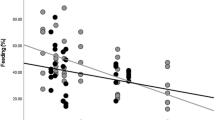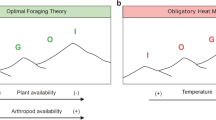Abstract
Baboons (Papio spp.) are characterised by a large degree of variation in foraging behaviour and dietary composition. Previous analyses have suggested that much of this can be traced to differences in ecological conditions between sites. The proximate mechanism underlying these relationships is assumed to be mediated via the impact of climatic conditions on food availability, and ultimately the impact that this has on dietary composition. This paper examines these relationships more explicitly. Data from 15 baboon populations were used to assess the relationship between foraging variables and dietary composition. Only feeding time showed significant relationships with dietary composition, with percentage of time spent feeding decreasing with proportion of fruit in the diet, and increasing with the proportion of subterranean items. No relationships were found between diet composition and moving time or day journey length, although significant relationships were found between these variables and group size. The proportions of feeding time spent feeding on fruit, subterranean items and leaves were functions of the ecological conditions experienced by that population, although no relationships were found for the percentage of feeding time devoted to flowers or animal material. The relationships between the proportion feeding time spent on fruits, leaves and subterranean items and ecological variables could be best explained through understanding the way in which bush and tree level vegetation respond to the climatic environment and the impact this has on fruit availability. In this respect, temperature and seasonality are the key climatic parameters. This provides good support for the idea that the proximate mechanism underlying the relationship between foraging time and ecological variables is mediated via the impact of the climatic environment on vegetation structure and food availability. Similar factors have been proposed to explain much of the geographic variation in species diversity, suggesting that these relationships have far wider relevance and may account for much of the observed geographical variation in mammalian behaviour.
Similar content being viewed by others
References
Altmann, S.A. (1991) Diets of yearling female primates (Papio cynocephalus) predict lifetime fitness. Proc. Natl. Acad. Sci. USA 88, 420–423.
Altmann, S.A. (1998) Foraging for Survival: Yearling Baboons in Africa. University of Chicago Press, Chicago.
Altmann, S.A. and Altmann, J. (1970) Baboon Ecology. University of Chicago Press, Chicago.
Altmann, S.A., Post, D.G. and Klein, D.F. (1987) Nutrients and toxins of plants in Amboseli, Kenya. Afr. J. Ecol. 25, 279–293.
Andrews, P. and O'Brien, E.M. (2000) Climate, vegetation, and predictable gradients in mammal species richness in Southern Africa. J. Zool. Lond. 251, 205–231.
Barton, R.A. (1989) Foraging strategies, diet and competition in olive baboons. Ph.D. Thesis, University of St. Andrews.
Barton, R.A., Byrne, R.W. and Whiten, A. (1996) Ecology, feeding competition and social structure in baboons. Behav. Ecol. Sociobiol. 38, 321–329.
Barton, R.A. and Whiten, A. (1994) Reducing complex diets to simple rules: food selection by olive baboons. Behav. Ecol. Sociobiol. 35, 283–293.
Barton, R.A., Whiten, A., Byrne, R.W. and English, M. (1993) Chemical composition of baboon plant foods: implications for the interpretation of intra-and interspecific differences in diet. Folia Primatol. 61, 1–20.
Barton, R.A., Whiten, A., Strum, S.C., Byrne, R.W. and Simpson, A.J. (1992) Habitat use and resource availability in baboons. Anim. Behav. 43, 831–844.
Bronikowski, A.M. and Altmann, J. (1996) Foraging in a variable environment: weather patterns and the behavioural ecology of baboons. Behav. Ecol. Sociobiol. 39, 11–25.
Bronikowski, A.M. and Webb, C. (1996) Appendix: a critical examination of rainfall variability measures used in behavioural ecology studies. Behav. Ecol. Sociobiol. 39, 27–30.
Byrne, R.W., Whiten, A., Henzi, S.P. and McCulloch, F.M. (1993) Nutritional constraints on mountain baboons (Papio ursinus): implications for baboon socioecology. Behav. Ecol. Sociobiol. 33, 233–246.
Cohen, J. (1988) Statistical Power Analysis for the Behavioural Sciences. 2nd edn. Lawrence Erlbaum, Hillsdale.
Currie, D.J. (1991) Energy and large-scale patterns of animal-and plant-species richness. Am. Nat. 137, 27–49.
Davidge, C. (1978) Ecology of baboons (Papio ursinus) at Cape Point. Zool. Afr. 13, 329–350.
Depew, L.A. (1983) Ecology and behaviour of baboons (Papio anubis) in the Shai Hills Game Production Reserve, Ghana. M.Sc. Thesis, Cape Coast University.
Dunbar, R.I.M. and Dunbar, P. (1974) Ecological relations and niche separation between sympatric terrestrial primates in Ethiopia. Folia Primatol. 21, 36–60.
Dunbar, R.I.M. (1988) Primate Social Systems. Chapman and Hall, London.
Dunbar, R.I.M. (1992a) Time: a hidden constraint on the behavioural ecology of baboons. Behav. Ecol. Sociobiol. 31, 35–49.
Dunbar, R.I.M. (1992b) A model of the gelada socio-ecological system. Primates 33, 69–83.
Dunbar, R.I.M. (1996) Determinants of group size in primates: a general model. In W.G. Runciman, J. Maynard Smith and R.I.M. Dunbar, (eds) Evolution of Social Behaviour Patterns in Primates and Man. Oxford University Press, Oxford, pp. 33–57.
Faul, F. and Erdfelder, E. (1992) GPOWER: A priori, post-hoc and compromise power analysis for MS-DOS [Computer program]. Bonn, FRG: Bonn University, Department of Psychology.
Gaynor, D. (1994) Foraging and feeding behaviour of chacma baboons in a woodland habitat. Ph.D. Thesis, University of Natal.
Haccou, P. and Meelis, E. (1992) Statistical Analysis of Behavioural Data. Oxford University Press, Oxford.
Hamilton, W.J. III, Buskirk, R.E.R. and Buskirk, W.H. (1978) Omnivory and the utilization of food resources by chacma baboons, Papio ursinus. Am. Nat. 112, 911–924.
Harding, R.S.O. (1976) Ranging patterns of a group of baboons (Papio anubis) in Kenya. Folia Primatol. 25, 143–185.
Hill, R.A. (1999) Ecological and demographic determinants of time budgets in baboons: implications for cross-populational models of baboon socioecology. Ph.D. Thesis, University of Liverpool.
Hill, R.A., Lycett, J.E. and Dunbar, R.I.M. (2000) Ecological and social determinants of birth intervals in baboons. Behav. Ecol. 11, 560–564.
Jolly, C.J. (1993) Species, subspecies, and baboon systematics. In W.H. Kimbel and L.B. Martin (eds) Species, Species Concepts, and Primate Evolution. Plenum Press, New York, pp. 67–107.
Kummer, H. (1968) Social Organisation of Hamadryas Baboons. Karger, Basel.
le Houérou, H.N. (1984) Rain use efficiency: a unifying concept in arid-land ecology. J. Arid. Environment. 7, 213–247.
McKey, D.B., Gartlan, J.S., Waterman, P.G. and Choo, G.M. (1981) Food selection by black colobus monkeys (Colobus satanas) in relation to plant chemistry. Biol. J. Linn. Soc. 16, 115–146.
Norton, G.W., Rhine, R.J., Wynn, G.W. and Wynn, R.D. (1987) Baboon diet: a five-year study of stability and variability of the plant feeding and habitat of the yellow baboons (Papio cynocephalus) of Mikumi National Park, Tanzania. Foila Primatol. 48, 78–120.
O'Brien, E.M. (1993) Climatic gradients in woody plant species richness: towards an explanation based on an analysis of southern Africa's woody flora. J. Biogeogr. 20, 181–198.
Popp, J.L. (1978) Male baboons and evolutionary principles. Ph.D. Thesis, University of Harvard.
Post, D.G. (1978) Feeding and ranging behaviour of the yellow baboon (Papio cynocephalus). Ph.D. Thesis, Yale University.
Rasmussen, D.R. (1978) Environmental and behavioural correlates of changes in range use in a troop of yellow (Papio cynocephalus) and a troop of olive (Papio anubis) baboons. Ph.D. Thesis, University of California, Riverside.
Rice, W.R. (1989) Analysing tables of statistical tests. Evolution 43, 223–225.
Sharman, M. (1981) Feeding, ranging and social organisation of the guinea baboon. Ph.D. Thesis, Yale University.
Sigg, H. and Stolba, A. (1981) Home range and daily march in a hamadryas baboon troop. Folia Primatol. 36, 40–75.
Stacey, P.B. (1986) Group size and foraging efficiency in yellow baboons. Behav. Ecol. Sociobiol. 18, 175–187.
Thomas, L. and Juanes, F. (1996) The importance of statistical power analysis: an example from Animal Behaviour. Anim. Behav. 52, 856–859.
van Schaik, C.P. (1989) The ecology of social relationships among female primates. In V. Standen, and R.A. Foley, (eds) Comparative Socioecology: The Behavioural Ecology of Humans and Other Animals. Blackwell Scientific publications, Oxford, pp. 195–218.
van Schaik, C.P., Noordwijk, M.A., de Boer, R.J. and den Tonkelaar, I. (1983) The effect of group size on time budgets and social behaviour in wild long-tailed macaques (Macaca fascicularis). Behav. Ecol. Sociobiol. 13, 173–181.
Whiten, A., Byrne, R.W., Barton, R.A., Waterman, P.G. and Henzi, S.P. (1991) Dietary and foraging strategies of baboons. Phil. Trans. R. Soc. Lond. B 334, 187–197.
Whiten, A., Byrne, R.W. and Henzi, S.P. (1987) The behavioural ecology of mountain baboons. Int. J. Primatol. 8, 367–387.
Whiten, A., Byrne, R.W., Waterman, P.G., Henzi, S.P. and McCullough, F.M. (1990) Specifying the rules underlying selective foraging in wild mountain baboons, P. ursinus. In M.T. De Mello, A. Whiten and R.W. Byrne (eds) Baboons: Behaviour and Ecology, Use and Care. University of Brasilia Press, Brasilia, pp. 5–22.
Williamson, D.K. (1997) Primate socioecology: development of a conceptual model for the early hominids. Ph.D. Thesis, University College, London.
Wrangham, R.W., Conklin, N.L., Chapman, C.A. and Hunt, K.D. (1991) The significance of fibrous foods for Kibale forest chimpanzees. Phil. Trans. Roy. Soc. B 334, 171–178.
Author information
Authors and Affiliations
Corresponding author
Rights and permissions
About this article
Cite this article
Hill, R., Dunbar, R. Climatic determinants of diet and foraging behaviour in baboons. Evolutionary Ecology 16, 579–593 (2002). https://doi.org/10.1023/A:1021625003597
Issue Date:
DOI: https://doi.org/10.1023/A:1021625003597




